
Rick Sherman
Farm to School / School Garden Coordinator
Oregon Department of Education
Office of Learning/Student Services
For more resources visit: https://goo.gl/FG5Hmq
UpdatedAugust,2016
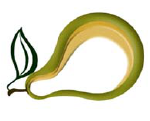
Oregon Department of Education
School Garden Food Safety Manual
StartupChecklists
WeeklyChecklists
HandlingFreshProduce
StaffTraining/Log
StudentTraining/Log
ComposngLogs
Tablabels:

Instrucons:
Readthecompanionguidefirst.Itwillguideyoustepbystep
throughthistraininganddocumentaonsystem.
TableofContents
Page1: SchoolGardenFoodSafetyProgramCompanionGuide
Tab1: SchoolGardenStartupChecklists
Tab2: SchoolGardenWeeklyChecklists
Tab3: USDABestPracces‐”HandlingFreshProduceinSchools”
Tab4: SchoolGardenStaffTraining&Log
Tab5: SchoolGardenStudentTraining&Log
Tab6: ComposngLogs
Oregon Department of Education
School Garden Food Safety Manual

Revised August, 2016
Oregon Garden Safety Companion guide 1
Oregon Department of Education
School Garden Food Safety
Training & Documentation Manual
~Companion Guide~
In Oregon, many people are resistant to serve food in their cafeterias that have been obtained
from school gardens. Sometimes there are misconceptions that serving this food might not be
allowed, or that serving the food from the gardens is unsafe. This is not the case, as long as
some simple food handling procedures are followed.
There are many guides and lists that deal with food safety in the school garden, but the
difference between those resources and this manual is that this manual enables the school to
document and have a written record of all training and procedures, thereby showing that the
operator has taken the necessary steps to ensure they’re doing everything possible to grow and
serve food safely to schoolchildren.
Fresh produce served in schools from school gardens in Oregon requires no formal food safety
inspection for unprocessed fruits and vegetables. Fruits or vegetables
may be considered
“unprocessed” if their food handling and preservation techniques have not changed the inherent
character of the item
. Examples of minimally processed food include cutting, drying, chopping
and freezing. Other foods in a school garden setting served from sources such as raising
chicken eggs, or processing beef or poultry at the school would require a lengthy inspection and
certification process, and could not legally be served in schools without this inspection and
certification.
All food served to the public or in school cafeterias from the school garden must be handled
following the same food handling procedures that are required by the local County Health
Department in Oregon. Other than local health regulations, there are no requirements or
regulations for school gardens. However, it is important to know that EVERYONE associated
with a school garden is responsible for the safety of the students and staff that work in the
garden or consume the food, and in fact can be liable for food safety related issues. For this
reason, the Oregon Department of Education has developed this garden safety program as a
way to potentially minimize risks associated with serving food from school gardens.
This manual is written with Oregon laws in mind. In other states, there are differing laws and
rules concerning the subjects discussed here. This manual is meant to be used as a tool to help
minimize risks associated with school gardens, and is not intended to be the “final word” on all
aspects of safe school gardening.
Note that these recommendations refer to food safety practices for both harvesting from the
school garden for consumption by others (in the garden or the cafeteria) and harvesting directly
for personal consumption. Safe food handling is always important, but is most critical when

Revised August, 2016
Oregon Garden Safety Companion guide 2
handling food consumed by others that is typically eaten raw (without a cooking step to kill
pathogens).
The following is an overview of what’s in the manual. Refer to the other sections to see
detailed steps and explanations of the material
Keep in mind the following:
• Documentation is a standard practice in the restaurant and cafeteria worlds. There’s a
saying that goes: “If it’s not documented, IT DIDN’T HAPPEN!” In other words, you have
to prove it happened by documenting it.
• If there’s ever an issue with a foodborne illness outbreak in your area, the school garden
could be at risk if there isn’t proper documentation available. If there are good records,
it will help tremendously by showing that your garden is doing everything possible to
minimize risks and ensure the safety of your garden.
• This system will only work if you actually DO what is documented.
CONTENTS of the School Garden Food Safety Training & Documentation Manual: (all items can be
found in the GARDEN SAFETY section of the ODE Farm to School/School Garden website)
https://goo.gl/FG5Hmq-Click on “School Gardens” box
• Companion Guide (this document)
• School Garden Startup Checklist (complete each Fall and Spring)
• School Garden WEEKLY CHECKLIST
• USDA “Best Practices – Handling Fresh Produce in Schools”
• School Garden Staff Training & Log
• School Garden Student Training & Log
• Composting logs
STARTUP CHECKLIST (Tab 1):
1. This checklist is to be completed twice per year. It’s recommended that the list be
completed once in the Fall (by September 30), and in the Spring (by April 30). Complete
a separate checklist each time. Enter the date in the appropriate space.
2. Enter the name of the designated adult that is in charge of the garden.
3. Enter at least one designated adult with current food handler certification that will be in
charge of handling the produce from the garden. This is usually the Kitchen Manager or
Cook, although it technically could be the same person. Oregon Food Handler permits
can be obtained online at www.orfoodhandlers.com
and are inexpensive. In a
foodservice environment all food handlers need to obtain a food handler permit. It’s
conceded that it’s impractical to have every student to have a food handler permit, but
at the least the leader or leaders of the garden who are in charge of harvesting food
should get one.
4. Identify soil history of the garden site. This will help determine areas of the garden that
aren’t suitable for growing food or may need special amendments.

Revised August, 2016
Oregon Garden Safety Companion guide 3
5. Soil should be tested for lead, arsenic and other major metals and contaminants. If you
are using the existing soil (rather than bringing in new soil), a one-time test should be
sufficient. Test new soil as it is added to the garden. It’s recommended to contact your
local OSU county extension office for referral to people who test soil. You can find your
local extension office/agent here: http://extension.oregonstate.edu/find-us
. Test for
lead and other contaminants that are identified through soil review. The extension
office should be able to assist you in determining what concerns there may be with your
soil. Soil with content greater than or equal to 400 mg of lead per kg is considered
potentially hazardous. Here are some other tips:
• Sample depth should be 4 to 6 inches, retrieve soil from several areas in your
garden.
• Contact the local utility companies (or call 811 – the national “call before you
dig” number) a few days before digging to ensure that you avoid gas or electric
lines.
6. WATERING/IRRIGATION: it’s recommended that only potable water should be used in
watering or irrigating a school garden. If municipal, potable (safe for drinking) water
used for irrigation (watering), then the water is being monitored by the municipality and
should be adequate for irrigation. NOTE: In a school district setting, the facilities
department will no doubt do an assessment of the garden’s source (building) plumbing
system to determine if the water supply is safe for the building, including any spigots
that are dedicated to irrigating the school garden. If not (if you are using well water,
water collection systems, etc.), test the water at least once a year. Water should be
tested for microorganisms, including E. Coli. This is not an expensive process. It is
recommended that you contact your local OSU county extension office for referral to
people who test water. Remember, water collection systems/containers should be
cleaned and sanitized regularly.
Lately, there has been a lot reported on building water supplies used for irrigation that
are not potable. For example, some schools have found elevated levels of lead in their
plumbing system that deems the water unsafe to drink. The Oregon Health Authority
has released a statement saying that “watering a school or community garden with lead-
containing water is OK, but test the soil for lead.” It’s recommended that if a non-
potable system is used as described above, the hose/spigot should be labeled so no one
drinks from that source. When it comes to evaluation of water sources, check with your
local health dept. for testing guidance, or with the Oregon Health Authority.
7. Garden watering system should be connected to a backflow preventer; this is
inexpensive and can be found at any hardware/home improvement store. Here’s a link
to one:
http://www.lowes.com/pd_306401-74985-
67750_0__?productId=3426508&Ntt=backflow+preventer&pl=1¤tURL=%3FNtt%
3Dbackflow%2Bpreventer&facetInfo=
8. The school garden plot should be positioned so that it is not in the path of runoff from
agricultural areas (such as livestock or dairy farms, etc.), parking lots, roads, or other
sources of potential contamination.

Revised August, 2016
Oregon Garden Safety Companion guide 4
9. ODE recommends that raised beds, containers, stakes or trellises are made of non-
toxic/non-leaching/non-pressure-treated materials. Corrective action: replace materials
in question, or at least use the areas near those materials for non-food only, such as
flowers. Have at least a 1-foot barrier from potential contaminants between the items
and areas where food items are grown. The Garden should not be placed next to a
building or any surface that has lead-based paint that could potentially flake off and
contaminate the garden.
10. Chemicals, including fertilizers, paints, lubricants, cleaning supplies etc. are not stored in
close proximity to the garden or to the harvested food. It’s best to keep these items in
their own specific secured area, such as a locked shed.
11. Staff Training: See “School Garden Staff Training & Log”
12. Student Training: See “School Garden Student Training & Log”
13. Seeds, plants and starts are obtained from reputable sources that are licensed to sell
them. Do not accept seeds, plants or food from household sources.
14. Consult with the necessary school and district staff. This includes the school principal
and the district Integrated Pest Management (IPM) Coordinator (often a facilities
manager), and any other staff you are advised to consult with before beginning.
15. Pesticides and insecticides are not to be used on school gardens.
a. Other than insecticidal soap, any pesticide products (including over-the-counter
baits for ants, rodents, etc.) used on school campuses must be applied by a
licensed pesticide applicator and each application must be accompanied by the
proper posting and notification as per Oregon’s school integrated pest
management law (ORS 634.700-634.750). For more information about school
IPM, see the Oregon State University School IPM Program page:
http://www.ipmnet.org/ti m/IPM_in_Schools/IPM_in_Schools-Main_Page.html
ODE recommends keeping this completed checklist on hand for the current plus three following
years.
WEEKLY CHECKLIST (Tab 2):
1. Composting: ODE recommends that you do not use cafeteria scraps for composting,
UNLESS the garden personnel and monitors are trained in compost management and
have a solid system in place that minimizes risks. Raw plant material tends to be very
safe, however if the school garden considers bringing in food scraps for the cafeteria the
compost will potentially be much more likely to attract pests and are more likely to
support the growth of harmful pathogens. A proper composting system includes:
a. Training staff and students in proper composting techniques
b. Documents time and temperatures required to destroy pathogens associated
with composting
c. Monitoring of composting stations (see below). Follow the criteria in the “Staff
Training” section (Tab 4) for procedures for composting.
Revised August, 2016
Oregon Garden Safety Companion guide 5
2. Collecting cafeteria scraps: ensure that the station is monitored (not just left alone in the
cafeteria) by an adult, or a trained, responsible student who can identify what should and
shouldn’t be composted.
Typically interest can wane and compost stations can be left
unattended. Proper monitoring is crucial to ensure that correct items are composted so
that harmful pathogen growth is not supported.
Best practices include:
a. Have a poster with pictures of items that are acceptable and unacceptable on it.
b. During an assembly, have a segment on composting. Students get behind the
process and are excited once they know the “whys” and what is going on.
Outside compost piles attract pests! Best practices for these systems include the
closed-system compost piles that have a lid to reduce pest activity. Buckets that
collect and deliver the compost to the pile should be washed/rinsed/sanitized.
3. Fertilizers and any soil or amendments treated with chemicals: follow instructions. Only
to be applied by adults.
4. Is there any evidence of “abuse” from animals? Including sightings of cats using the
beds as a litter box, rodent activity, deer activity, etc.
a.
Corrective action: If there is evidence of animal abuse (feces or urine) in the
garden, food in that area should NOT be harvested for human consumption.
b. Remove and discard part of plant/soil that is affected by contamination.
c. Try to keep animals out by erecting fencing, or traps, etc. There have been
success stories with solar-powered electric fencing perimeters to control
persistent problems; however you would have to consider that small children are
also near these systems, you would need to consider ensuring that precautions
were in place to protect the children, like a “caution tape” barrier between kids
and the fencing.
d. To discourage abuse such as vandalism, consider surveillance cameras and signs
showing the garden is monitored. At the minimum, the garden should be
monitored regularly by staff or volunteers.
5. All students/staff have access to restrooms (with potable hot running
water/soap/disposable towels.
6. Everyone must properly wash their hands with soap and warm water before harvesting
food to be served to the public. Best practices include having the class line up at the
restroom just as they would before lunch service. *NOTE* This process is for
HARVESTING food for the cafeteria or public consumption. Also, students should wash
their hands with soap and warm water after having their hands in contact with the soil.
7. Any students or staff who exhibit symptoms of serious illness (vomiting, fever, or
diarrhea) should be prevented from handling produce in the garden so they won’t
spread harmful bacteria and germs. Typically these individuals shouldn’t be at school,
but have non-food contact activities for these students and staff in case.
8. For safety and sanitation, it is recommended that all students and staff wear close-toed
shoes. Flip-flops and bare feet pose physical safety and sanitation issues.
9. If manure is used, use only commercially prepared manure on the school garden. This
substantially decreases the risk in introducing harmful bacteria to the food.
Revised August, 2016
Oregon Garden Safety Companion guide 6
10. Irrigation (for watering) for the school garden should be from a municipal source. If any
other source of water is used, including well water or a rain collection system it should
be tested (see startup checklist) twice a year. Water collecting containers should be
cleaned and sanitized on a regular basis.
11. Insecticides/pesticides should not be used in a school garden. The application of these
anywhere on school campuses is regulated by state law. A district’s IPM Coordinator
must be contacted for pest issues, and situations requiring the use of pesticide products
on school grounds.
12. Harvesting, storing and serving: Containers used to harvest/transport food should be
non-porous, food grade, and easy to sanitize. Do not use: burlap bags; single-use
grocery bags; wicker baskets. For assistance with specific examples of items that are
safe to use, contact your local food service/cafeteria.
13. USDA “Best Practices for Handling Fresh Produce in Schools” (Tab 3) should be followed
for harvesting/cleaning the produce (attached in this guide). It is very common for the
garden staff to harvest the food and deliver it to the cafeteria staff. The cafeteria staff
in Oregon is trained in handling the produce correctly (if they are a part of the National
School Lunch Program). If they are not available for a harvest, the garden coordinator
needs to follow the procedures contained in the handout.
a. A note about MUSHROOMS: If mushrooms are grown in a school garden, the
mushroom starts or spores (most common grown are oyster mushrooms) must
be sourced from reputable sources. Under no circumstances should anyone
harvest wild mushrooms for any reason.
14. If the produce will be harvested to be consumed at a later time, the harvested items are
to be properly labeled and refrigerated or appropriately stored following the principles
in the attachment listed in #13.
15. Recommended procedure for harvesting should be to remove soil by using a dedicated
place, such as washing station outside, possibly near the garden first before delivering
the produce to the kitchen-as a first step to prevent cross-contamination.
16. All tools and utensils need to be properly cleaned and free of dirt at the end of the day.
Any tools/utensils that come into contact with food need to be properly cleaned and
sanitized:
a. Scrape any soil/debris off tool
b. wash with warm soapy water
c. rinse
d. Sanitize using proper sanitizer, using iodine, quaternary or chlorine bleach
e. Use corresponding test strip to ensure proper strength of sanitizer. Contact your
cafeteria to find out how to purchase test strips and sanitizer, as every cafeteria
utilizes them.
Keep these completed weekly logs for the current plus three years.
STAFF TRAINING & LOG (Tab 4):
• It is recommended that at least one person (typically the School Garden
Coordinator) attend a school garden certification course. These courses take
place in the summer typically, and are usually four or five days in length. They
Revised August, 2016
Oregon Garden Safety Companion guide 7
provide overall garden management training and have a garden food safety
component.
• All staff members should be trained using the staff training and log before
working in the garden. Have the staff sign the training log and keep for one year.
• Complete yearly, retain for current plus three years.
STUDENT TRAINING & LOG:
• All students should be trained using the student training and log before working
in the garden. Have the students sign the training record-or, have the teacher
indicate the classroom that was trained, and keep for one year.
• Retain for current plus three years.
COMPOSTING LOG(S):
• Depending on whether you utilize hot or cold composting (or both), it is crucial
that you document the proper procedure and process you follow by utilizing
these logs.
• Retain for current plus three years
Revised August, 2016
Oregon Garden Safety Companion guide 8
Thank you to the following people in developing of this program:
Caitlin Blethen, Youth Grow Manager, Growing Gardens, Portland OR
Frank A Brown, et al., Oregon Environmental Health Licensing Supervisor,
Conference of Local Environmental Health Supervisors
Chris Bosak, Oregon Department of Education Child Nutrition Services
Kari Christensen, Brownfields Program Coordinator, Oregon Health Authority
Public Health Division
Anne Donahue, City of Eugene Oregon Compost Program
Patty Driscoll, Compost Specialist Committee Chair, Oregon State University Extension Service
William Fargo, Food Safety Specialist, Food Safety Division, Oregon Department of Agriculture
Lisa Carolina Gonzalez, University of Maryland Extension
Kristin Hall, Child Nutrition Specialist, Oregon Department of Education
Matt Hoffman, MPH REHST, Health Educator, Registered Environmental Health Specialist
Trainee, Multnomah County Environmental Health
Stewart Jacobsen, Food Safety Projects Coordinator, Agricultural Consultation and Training,
Arizona Department of Agriculture
Ashley Jeppson, Nevada Department of Agriculture
Megan Kemple, Willamette Farm and Food Coalition
Gail Langellotto, Ph.D. Statewide Coordinator,
Oregon State University Extension Master Gardener Program
Andrew Nowak, Co-Director, National School Garden Program, Slow Food USA
Michelle Markesteyn Ratcliffe, Farm to School Coordinator, Oregon Department of Agriculture
John Moriarty, School Garden Project of Lane County
Katy Pelissier, Farm to School Coordinator, Ecotrust
Ashley Schimke, Farm to School Specialist, Arizona Department of Agriculture
Jennifer Snyder, Faculty Research Assistant, School IPM Specialist, Oregon State University
Erica Steinhart, Farm to School Specialist, DC Office of the State Superintendent of Education
Anne Wilson, Denver Public Schools
Jennifer Young, Nutrition and Physical Activity Coordinator, Oregon Health Authority

Revised August, 2016
Oregon Garden Safety Companion guide 9
In accordance with Federal civil rights law and U.S. Department of Agriculture (USDA) civil
rights regulations and policies, the USDA, its Agencies, offices, and employees, and institutions
participating in or administering USDA programs are prohibited from discriminating based on
race, color, national origin, sex, disability, age, or reprisal or retaliation for prior civil rights
activity in any program or activity conducted or funded by USDA.
Persons with disabilities who require alternative means of communication for program
information (e.g. Braille, large print, audiotape, American Sign Language, etc.), should contact
the Agency (State or local) where they applied for benefits. Individuals who are deaf, hard of
hearing or have speech disabilities may contact USDA through the Federal Relay Service at
(800) 877-8339. Additionally, program information may be made available in languages other
than English.
To file a program complaint of discrimination, complete the
USDA Program Discrimination
Complaint Form, (AD-3027) found online at:
http://www.ascr.usda.gov/complaint_filing_cust.html, and at any USDA office, or write a letter
addressed to USDA and provide in the letter all of the information requested in the form. To
request a copy of the complaint form, call (866) 632-9992. Submit your completed form or letter
to USDA by:
(1) mail: U.S. Department of Agriculture
Office of the Assistant Secretary for Civil Rights
1400 Independence Avenue, SW
Washington, D.C. 20250-9410;
(2) fax: (202) 690-7442; or
(3) email: program.intake@usda.gov.
This institution is an equal opportunity provider.
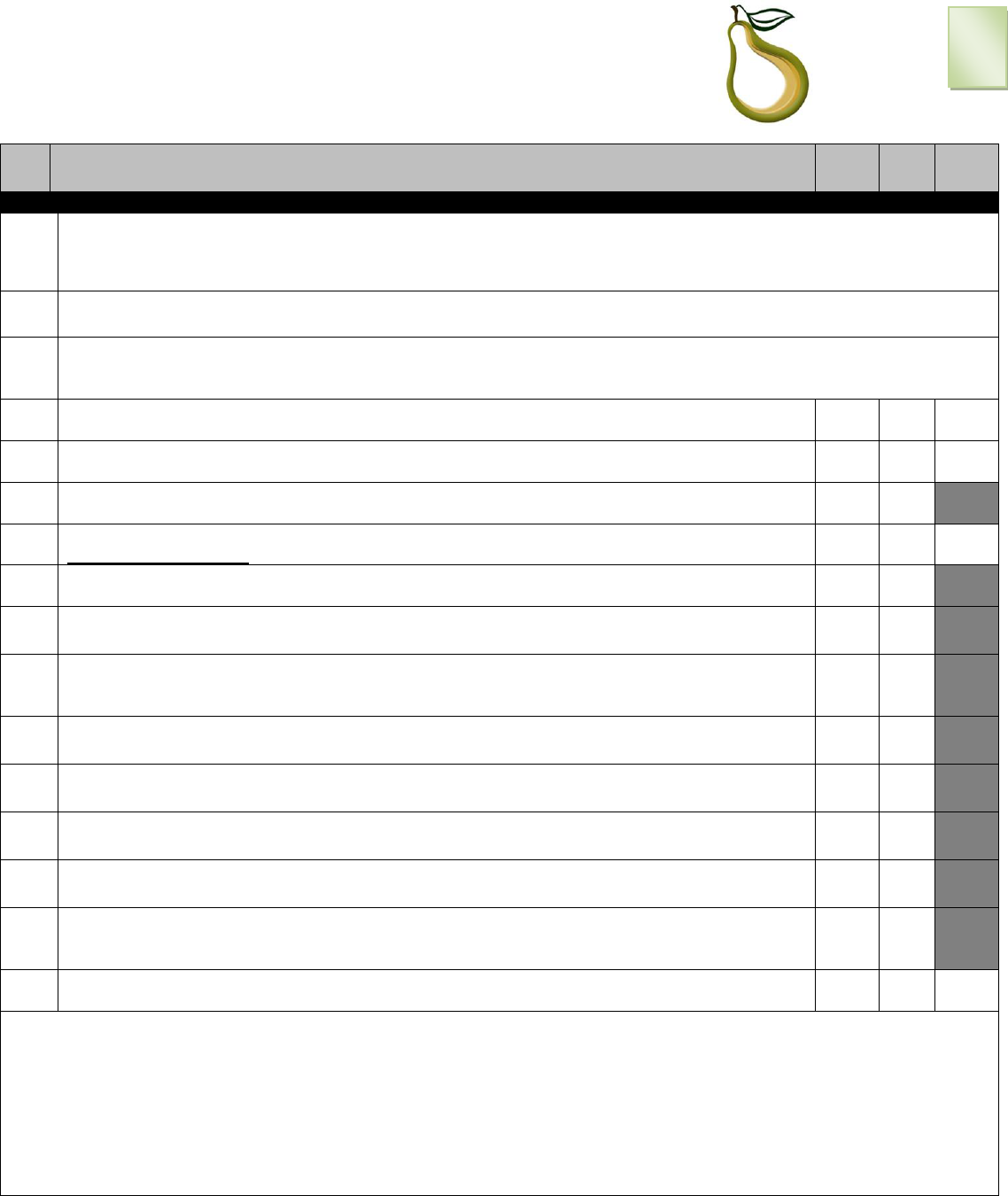
Oregon Department of Education
School Garden Food Safety Program
~Start-Up Checklist~
REVISED: August 2016 COMPLETE TWICE A YEAR
Tab 1, pg 1
NO
ITEMS TO CHECK
YES
NO
N/A
1
FALL (DATE)________________________________ (complete by Sep. 30)
SPRING (DATE)_____________________________ (complete by April 30)
2
Identify Garden Coordinator, person who is in charge of this garden
(Name, Title):__________________________________________________________________________
3
At least one designated adult with a current county food handler certification must supervise all preparation of food
from the garden served at school, including harvesting, washing, preparing and cooking of the food.
(Name/Title):___________________________________________________________________________
4
Soil: Identified soil history of the garden site (only needs to be done once)
5
Soil: Soil has been tested for lead, arsenic and other major metals and contaminants. (needs
to be done once unless reintroducing more soil at a later date) Attach test results to this form.
6
Irrigation: is municipal water used?
7
If not, water is tested for total coliform bacteria and other microorganisms such as E. Coli
at least once per year. Attach test results to this form.
8
Irrigation: watering system should be connected to a backflow preventer; inexpensive piece
available at hardware store (See implementation guide for link to product)
9
Growing plot is positioned so that it is not in the path of runoff from agricultural areas, parking
lots and roads, or other sources of potential contamination.
10
Raised beds, containers, stakes or trellises are made of non-toxic/non leaching/non pressure-
treated materials. Corrective action: for non-food (flowers) or at least a 1-foot non-food
barrier. Garden location should be placed away from lead-painted surfaces.
11
Chemicals, including fertilizers, paints, lubricants, cleaning supplies etc. are not stored in
close proximity to the garden or to the harvested food
12
TRAINING: All garden staff have completed Staff Training and Log before working in the
garden and supervising students.
13
TRAINING: All students have completed Student Training and Log before working in the
garden.
14
Seeds and/or plants are procured from reputable sources
15
You have connected with the district Facilities person / integrated pest management (IPM)
Coordinator to discuss proper location of garden and any compost areas.
Corrective Action:
Tab 1

Oregon Department of Education
School Garden Food Safety Program
~Start-Up Checklist~
REVISED: August 2016 COMPLETE TWICE A YEAR
Tab 1, pg 2
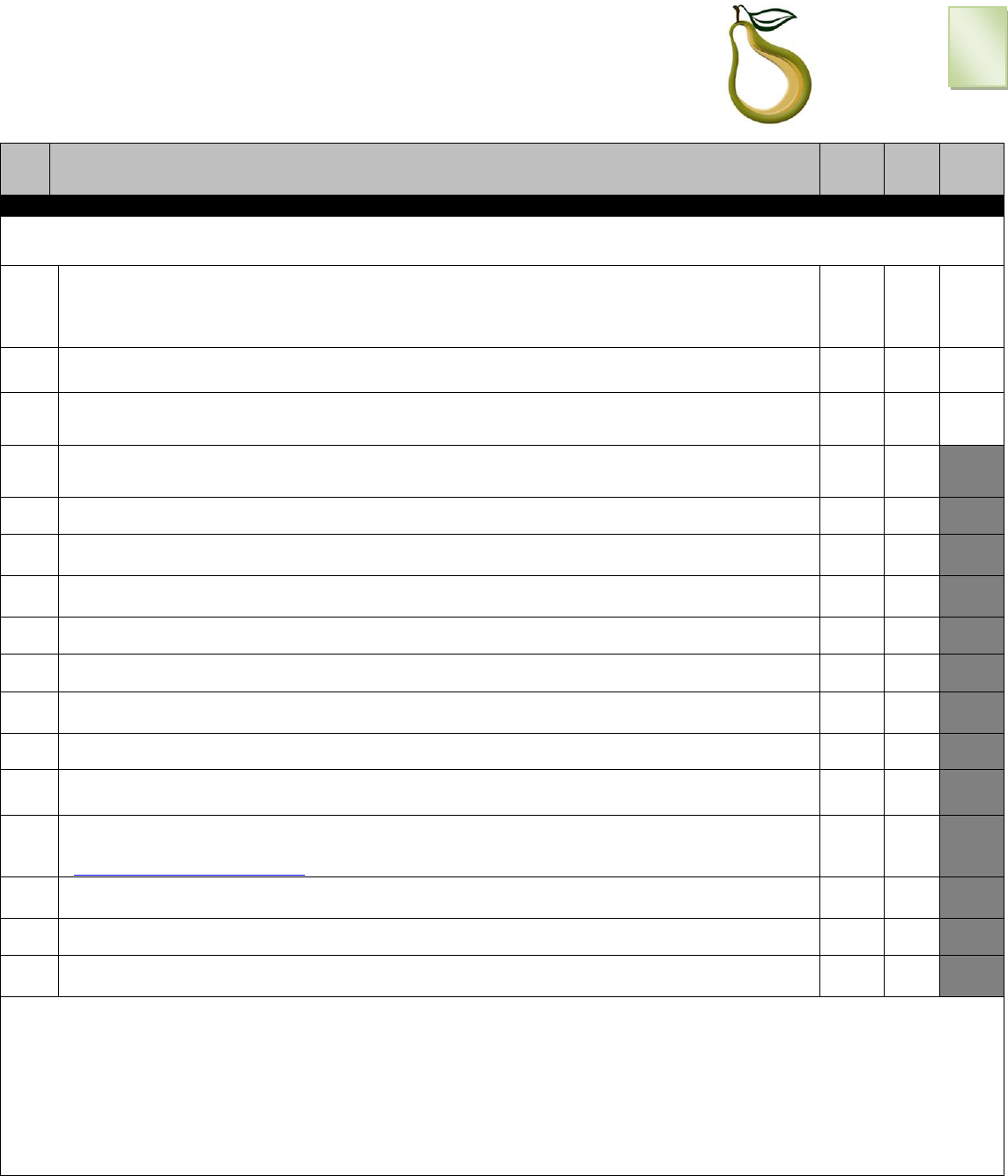
Oregon Department of Education
School Garden Food Safety Program
~Weekly Garden Checklist~
REVISED: August 2016
Tab 2 Pg 1
NO
ITEMS TO CHECK
YES
NO
N/A
WEEK OF (DATE)______________________________________
1
Employing Best Composting Practices (Lane County Extension Service Compost Specialist
Program –see staff training section/tab 4): Compost log is completed as to instructions on the
log
2
Compost collection station in cafeteria is staffed and monitored by an adult or a trained student
3
Label instructions for the use of soils and fertilizers are being followed. Fertilizers are only
applied by adults.
4
There is no evidence of abuse from domestic and/or wild animals. Garden is regularly
monitored.
5
All Students/Staff have access to restrooms (with potable hot running water/soap/paper towels)
6
Proper personal hygiene practices are in place: All students/staff wash hands before
harvesting food for public.
7
Persons who are ill (vomiting, fever, diarrhea) are prevented from working in a garden and
handling food
8
All students/staff should wear closed-toed shoes.
9
Untreated (not commercially prepared) manure is not being used
10
Gray water, waste water, recycled water from any source, or runoff water from parking lots is
not being used
11
Insecticides and/or pesticides are not used
12
Containers used to transport harvested items are food-grade, properly cleaned and in good
condition
13
USDA “Best Practices for Handling Fresh Produce in Schools" (vegetable harvesting/cleaning)
procedures are being followed for those items being used in cafeteria or otherwise consumed.
(www.nfsmi/producesafety.org – search “handling fresh produce” )
14
Harvested items are labeled and properly stored prior to use in cafeteria or otherwise
consumed.
15
Soil from produce is removed at an outside washing station first before delivering to kitchen.
16
At end of the day, tools are properly cleaned and stored. Tools and utensils that come in
contact with food are properly cleaned and sanitized
Use next page for any corrective action
Tab 2

Oregon Department of Education
School Garden Food Safety Program
~Weekly Garden Checklist~
REVISED: August 2016
Tab 2 Pg 2
CORRECTIVE ACTION for any items marked “NO” above: Use other side. See companion guide for help on
corrective actions.

Fruits and vegetables are an important part of a healthy diet. Introducing
children to them in schools will improve their present and future health.
Fresh produce must be handled safely to reduce the risks of foodborne
illness. There are a number of steps that foodservice employees can take
to minimize the chances for fruits and vegetables they handle to become
contaminated. Best practices for handling all types of produce are
described in this fact sheet, along with practices specic to leafy greens,
tomatoes, melons, and sprouts.
Contamination of produce with harmful microorganisms can occur
at all stages of production, processing, transportation, storage,
preparation, and service. To prevent foodborne illness, fresh produce
needs to be handled with care at each step from farm to table.
BEST PRACTICES
HANDLING FRESH PRODUCE IN SCHOOLS
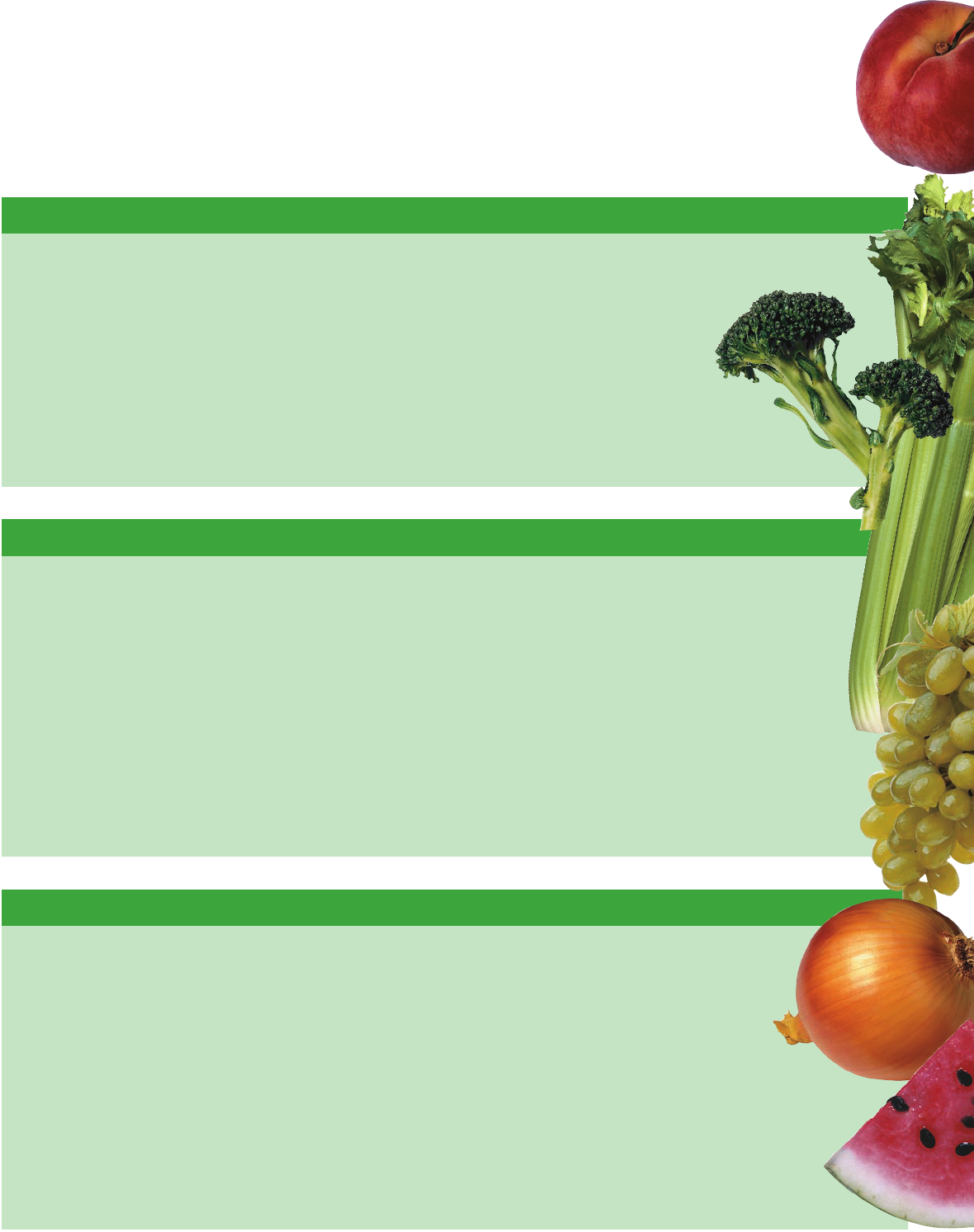
Recommendations For
Handling Fresh Produce
O Inspect produce for obvious signs of soil or damage prior to cutting, slicing, or dicing.
When in doubt about damaged produce, either cut away the aected areas or do not use the item.
O Wash produce before serving or cutting using either:
Continuous running water.
Chemical disinfectants, used according to the manufacturer’s label instructions for recommended
concentration and contact time. Note: Do not soak produce or store in standing water.
O Do not rewash packaged produce labeled “ready-to-eat,” “washed,” or “triple washed.”
O Wash thoroughly with hot soapy water all equipment, utensils, and food contact surfaces that come
into contact with cut produce. Rinse, sanitize, and air-dry before use.
WASHING AND PREPARATION
O Wash hands thoroughly with soap and water before handling or cutting fresh produce.
Rewash hands after breaks, visiting restrooms, sneezing, coughing, handling trash or money,
or anytime hands become soiled or otherwise contaminated.
O Use a barrier such as gloves, deli paper, or an appropriate utensil to touch ready-to-eat produce.
Note: This does not eliminate the need for frequent proper handwashing.
O Always wash hands before putting on disposable gloves.
O Change disposable gloves anytime the gloves may have been contaminated or when changing tasks.
O Do not wash or reuse disposable gloves.
O Change disposable gloves if they are torn or damaged.
HAND HYGIENE
O Use purchasing specications that include food safety requirements, such as maintaining produce
at the proper temperature, maintaining clean and pest-free storage areas and delivery vehicles,
and complying with federal and state food safety laws and regulations.
O Ensure suppliers are getting produce from licensed, reputable sources.
O Check storage and handling practices of vendors.
O Establish procedures for inspecting and accepting or rejecting incoming deliveries. Procedures
should include checking the condition of the fresh produce and the transportation vehicles to
make sure specications are met.
PURCHASING AND RECEIVING
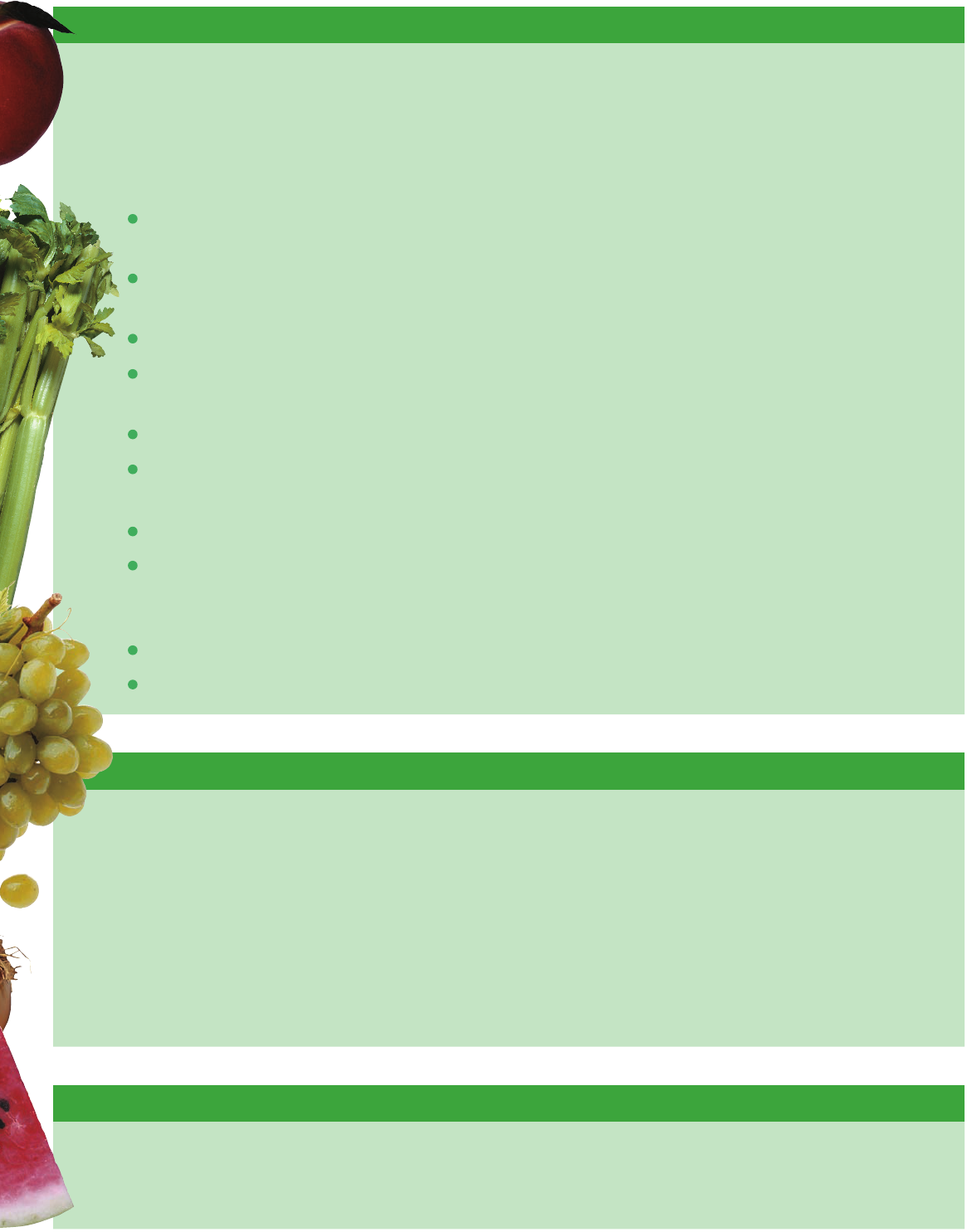
O Develop training programs to teach the importance of food safety and proper handling of produce to all
food handlers.
O Practice good food safety and food handling techniques to prevent cross-contamination.
TRAINING AND GENERAL FOOD SAFETY PRACTICES
O Maintain produce at the temperature recommended for the variety and particular stage of ripeness.
O Store produce at least 6 inches o the oor, including in walk-in refrigerators.
O Store produce in a covered container and above other items that might cause contamination.
O Follow manufacturer’s instructions for the product such as “keep refrigerated” or “best if used by.”
O Establish a policy for produce that is cut in-house to specify how long the refrigerated cut product may be
used. Mark the product with “prepared on” or “use by” date.
O Wash produce just before preparation, not before storage.
STORAGE
O Do not store produce in direct contact with ice or water while on display on serving lines and salad bars.
O Mark the time when cut produce is displayed without refrigeration. Display cut produce for a maximum of 4
hours if not in a refrigeration unit or containers surrounded by ice. Discard any uneaten produce at the end
of 4 hours.
O Create safe salad bars and self-service lines by taking the following actions:
Protect food with sneeze guards or food shields in a direct line between the food and the mouth or
nose, usually 14 to 18 inches above the food.
Use cleaned and sanitized long-handled tongs, spoons, and ladles so bare hands do not touch food and
the utensils do not drop into the serving pans.
Change utensils periodically.
Set up the salad bar or self-service line as close to mealtime as possible to reduce the time that produce
sits out.
Keep cold foods at or below 41°F in a refrigeration unit or surrounded by ice.
Monitor and document the internal temperature of self-service items every 30 minutes as with other
foods on the service lines.
Clean up spills promptly. Wiping cloths should be stored in sanitizing solution and laundered daily.
Teach children salad bar etiquette. Assign an adult to monitor the salad bar and self-service line to make
sure the customers—especially children—are not touching food with their hands, tasting food while in
line, putting their heads under the sneeze guard, or returning food items.
Clearly label all salad dressings and other containers to discourage tasting.
Never add freshly prepared food to food already on salad bars and self-service lines.
SERVING

O Avoid using whole melons that have
visible signs of decay or damaged rinds
(such as mechanical damage or cracking)
due to the increased risk that harmful
bacteria may have contaminated the
melons.
O Wash the outer surface of the melon
thoroughly under running cool tap water
to remove surface dirt. Scrub melons with
a clean produce brush before cutting.
Cut away any bruised or damaged areas
before serving.
O Discard cut melons after 4 hours if
maintained at 41°F or above. If possible,
display cut melons in a refrigerated case,
not just on top of ice.
O Display cut melons for a maximum of
4 hours without being kept cool with
refrigeration or ice and discard uneaten
melons at the end of 4 hours.
O Mark the date on refrigerated cut melons
to indicate that they must be consumed
or discarded within 7 days.
O Do not wash tomatoes in cold water. Use
wash water temperatures that are at least
10°F warmer than the internal tomato
temperature to prevent exterior bacteria
from entering the interior of the tomato
during washing.
O Ensure whole tomatoes are free from
obvious signs of soil and skin damage,
such as punctures, prior to cutting, slicing,
or dicing. Either cut away any bruised or
damaged areas, or do not use the tomato.
O Hold tomatoes at 41°F or below after cutting,
including during display on serving lines and
salad bars.
O Ensure the temperature of tomatoes
purchased as fresh-cut (i.e., sliced, diced, or
chopped) is 41°F or lower upon delivery and
the tomatoes were kept cool continuously
during transport. Reject fresh-cut tomatoes
delivered at a temperature higher than
41°F.
O Mark the date on refrigerated cut tomatoes
to indicate that they must be consumed or
discarded within 7 days.
O Do not store cut tomatoes in direct contact
with ice or water.
O Do not use leafy greens with visible signs
of decay or damage because there is an
increased risk of the presence of harmful
bacteria. When in doubt about the use
of decayed or damaged product, either
remove the unusable portions or do not
use the leafy greens.
O Do not rewash packaged produce labeled
“ready-to-eat,” “washed,” or “triple washed.”
Due to the increasing number of illnesses
associated with eating raw sprouts,
the Food and Drug Administration
has advised all consumers—especially
children, pregnant women, the elderly,
and persons with weakened immune
systems—to not eat raw sprouts as a way
to reduce the risk of foodborne illness.
All sprouts should be cooked thoroughly
before eating to reduce the risk of illness.
SPROUTS
MELONS TOMATOES LEAFY GREENS
Council for Agricultural Science and Technology. Food Safety and Fresh Produce: An Update.
Available at http://www.cast-science.org/publications.asp
Food and Drug Administration. Draft Guidance for Tomatoes, Leafy Greens, and Melons.
Available at http://www.fda.gov/Food/FoodSafety/Product-SpecicInformation/FruitsVegetablesJuices/FDAProduceSafetyActivities/ucm174086.htm
Food and Drug Administration. Safe Handling of Raw Produce and Fresh-Squeezed Fruit and Vegetable Juices.
Available at http://www.cfsan.fda.gov/~dms/prodsafe.html
National Restaurant Association. Guidelines on How to Keep Salad Bars Safe.
Available at http://www.restaurant.org/foodsafety/how_to_salad.cfm
U.S. Department of Agriculture. Fresh Fruit and Vegetable Program Handbook.
Available at http://www.fns.usda.gov/cnd/FFVP/Resources/FFVPhandbookFINAL.pdf
U.S. Department of Agriculture. Fruits & Vegetables Galore: Helping Kids Eat More.
Available at http://www.fns.usda.gov/TN/Resources/fv_galore.html
This project has been funded at least in part with funds from the USDA Food and Nutrition Service. The content of this publication does not necessarily reect the views or policies of the
Department, nor does mention of trade names, commercial products, or organizations imply endorsement by the U.S. Government.
The University of Mississippi is an EEO/AA/Title VI/Title IX/Section 504/ADA/ADEA Employer.
Please feel free to reproduce and distribute this publication. Copies are also available on our Web site: www.nfsmi.org
Information about this and other topics may be obtained by contacting the
NATIONAL FOOD SERVICE MANAGEMENT INSTITUTE,
The University of Mississippi; Telephone: 800.321.3054; Item number ET100-10
Recommendations For Specific Types Of Produce
Resources

Revised August, 2016
Tab 4, pg 1
Oregon Department of Education
School Garden Food Safety Program
Staff Training Manual and Log
• Someone who is in charge of food from the garden that is going to be harvested,
prepared and served to the public MUST have a current food handler’s card. This
person is usually the kitchen manager, but it’s recommended that the garden
coordinator get one so they know the proper food handling procedures. They are
inexpensive and available at www.orfoodhandlers.com
• ODE recommends that (at least) the Garden Coordinator be certified through a school
garden training certification course.
o In Oregon, Growing Gardens in Portland hosts school Garden Coordinator
Certificate Trainings. They are typically held in the summer, and are in multiple
locations throughout the State. You can find out all information by going to
www.growing-gardens.org, and then go to the “resources” tab, and scroll down
to “school gardens.”
o Another option is the Oregon 4-H Gardens Teacher and Volunteer Winter
Training by Oregon State University in Multnomah County. Contact Maureen
Hosty at 503-916.6075. Website: Google “Oregon 4H school garden teacher and
volunteer training”
o Cornell online training / GHP GAP (good handling practices/good agricultural
practices www.gaps.cornell.edu
-$190
• The Garden Coordinator, Kitchen Manager or Cook, Food Service Director, Principal, and
any other key stakeholders (like Facilities folks / Integrated Pest Management (IPM)
Coordinator) should meet at the beginning of the school year so they all have a common
understanding and agree about all things relating to the garden. The items discussed
should be things such as: who is responsible for cleaning harvest containers; compost
station locations; delivery times of produce; etc.
• The following are general guidelines that should be followed to ensure food safety in
your garden. Remember, children are in an age group that is highly susceptible to
foodborne illness.

Revised August, 2016
Tab 4, pg 2
When a school serves food from a school garden to students or the public, there are the same
concerns as a cafeteria purchasing from a distributor or farm. There is an opportunity to make
people sick if simple procedures aren’t followed.
Hygiene: All students/staff w
ash hands thoroughly with soap and water before harvesting food to be
served to the public. When harvesting, rewash hands after breaks, visiting restrooms, sneezing,
coughing, handling trash or money, or anytime hands become soiled or otherwise contaminated. After
produce is washed and ready to be served in the cafeteria, barriers such as gloves, deli paper or
appropriate utensil should be used to touch ready-to-eat produce.
SPECIFICALLY, here is the procedure for hand washing when serving food to the public:
• Wash hands with warm, soapy water for 20 seconds
• Before and after handling food
• After using the bathroom*
• After blowing your nose, coughing or sneezing*
• Dry hands with single-use, di sposable towels
*Note: when handling ready to eat food, the Oregon food handling rules state that after the above
actions occur (bathroom break/blowing nose) the food handler must double-wash their hands. This
means washing their hands in the restroom, and again at the hand washing station when returning to
the worksite, typically a cafeteria. However, the Oregon health codes also stipulate that some
workplaces will probably NOT have a proper hand washing sink available – like in a garden. In this case,
the second step is not required, however harvester must take special attention and make sure they do
an adequate job after going to the restroom or blowing their nose.
It’s crucial that ANY student or staff be excluded from gardening activities if they are ill, exhibiting
symptoms such as vomiting, diarrhea or fever, so they will not spread bacteria leading to foodborne
illness. Typically, students who are ill should not be at school anyway, so this shouldn’t be an issue.
Composting: Composting cafeteria scraps can bring serious problems to the school. Compost
piles can attract pests and potentially introduce harmful bacteria if the system is not done
properly and monitored very carefully. ODE recommends that you do not use cafeteria scraps
for composting, UNLESS your school garden staff (and students involved) are properly trained
and have a solid system in place to ensure that you are minimizing risks associated with
composting.
• One effective form of a cafeteria compost station is a table with holes cut into them and
5-gallon buckets placed in the holes.
Have a poster with pictures available showing what to compost and NOT to compost. The
provided examples are available on our website:
https://goo.gl/FG5Hmq
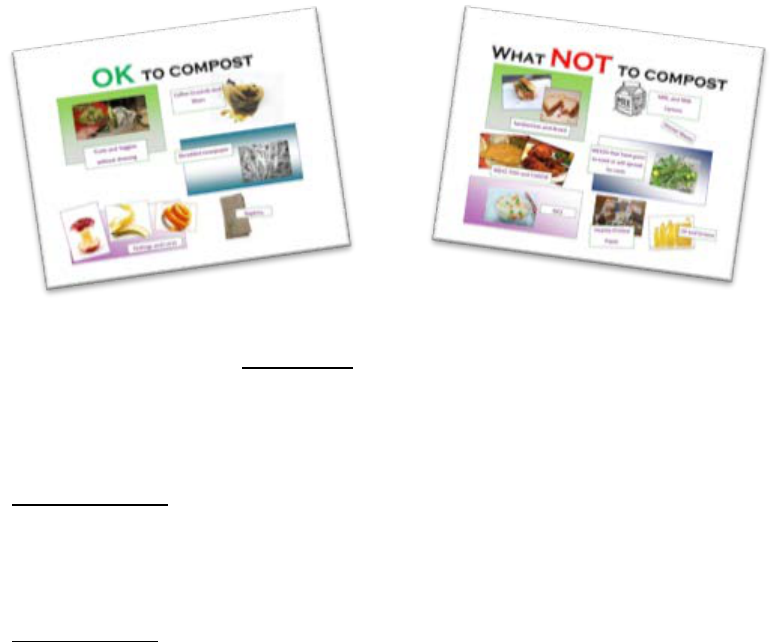
Revised August, 2016
Tab 4, pg 3
• . Click on the “School Garden” box and scroll down to the “Garden Safety” section.
School assemblies work very well to educate the students all at once, showing examples
of what’s ok to compost. Composting can generate excitement about the garden, too.
• Have a trained adult or responsible student monitoring the composting station during
meal service period. Responsible students should be trained on this composting system.
• After the material is delivered to the compost pile, the buckets need to be cleaned and
sanitized.
• Do not compost: bread & rice (doesn’t break down in the same way as others, and
introduces harmful molds); meat products; dairy products; heavily coated or printed
paper; magazines; oil of any kind; animal feces; sawdust (unless you know if all of the
wood was untreated); diseased plants; weeds that are spread by roots or gone to seed.
• OK to compost: fruit and vegetable food scraps that are free of dressing or oils; banana
peels; orange peels; melon rinds; apple cores; napkins; grass clippings; leaves; straw;
shredded cardboard; coffee grounds and coffee filters.
• Although most all materials will eventually decompose, an efficient compost pile should
have a 2:1 ratio of “browns” (leaves, cardboard, etc.) to “greens”(grass clippings,
veggies) (known as a “C:N” ratio – carbon/nitrogen).
• Compost procedure:
o Complete the composting log (included in this guide), following these
procedures:
o For “hot composting,” internal temperature should read at least 131 degrees for
three days, then turned two times and reach 131 degrees after each turn at
least.
o Do not let the pile get above 140 degrees
o The pile should then be cured for 3 months.
o Note: The pile needs to be three cubic feet in size for doing hot compost and
you will need to adjust the C:N ratio to reach the required temperatures to kill
pathogens. Consult your OSU extension office for more guidance.
Revised August, 2016
Tab 4, pg 4
o Composting thermometer used should be regularly calibrated. To calibrate a bi-
metallic stem thermometer, fill a cup with crushed ice, and then top it off with
water. Immerse the end of the thermometer in the cup and stir around. The
needle should read at exactly 32 degrees. Adjust the nut on the underside of the
dial until this number is reached. Document when you do this procedure on the
composting log.
o For “cold” composting, pile should be protected from pests and cured for at least
one year after the last time last is added to the pile.
o Cold composting can take up to two years to completely break down!
Harvesting: Containers must be easily cleanable, non-porous, and food-grade. All implements
and containers that come in contact with produce must be washed/sanitized.
Preparing harvested fruits and veggies: Typically harvested food from the garden is delivered
to the cafeteria via a prior arrangement. The produce should be free and clear of soil. Typically
this is done by pre-washing the produce at a washing station near the garden BEFORE delivery
to the cafeteria/kitchen. The cafeteria staff would then prepare the produce, but in many cases
this might be done by the garden staff. One of the most common problems is that school
garden produce typically has a lot more dirt and bugs associated with the produce than
produce purchased from conventional sources. This is why it’s crucial to pay special care in
cleaning and prepping. Produce must be washed THOROUGHLY! Cafeteria staff sometimes has
to double/triple wash school garden produce.
Animal activity: Including rodents, cats, and deer. It’s important to remember that a typical
garden is in the animal’s natural environment. It’s almost impossible to keep animals
completely out of the garden; however fencing or cages should reduce animal activity. Animals
can sometimes jump over the tallest fencing. Other considerations to keep in mind:
• You might want to make a small-gauge chicken wire or similar fencing to keep rodents
from getting through easily.
• Also, burying the wire a few inches into the ground discourages animals to burrow
under.
• Netting to discourage deer and birds
• Surveillance, signs and/or at least regular monitoring to discourage “two-legged” pests
or vandalism.
• It is important to realize that you cannot totally keep out all pests from a garden no
matter what steps you take! It may be possible to minimize the pest activity by
following some of the steps listed above. Consider “flagging” areas where animal abuse
occurs, remove plant and dirt that’s been contaminated.

Revised August, 2016
Tab 4, pg 5
Eating “right out of the garden:” Only produce that is not in direct ground contact and shows
no obvious signs of soil or other contamination should be eaten directly (“grazing”). Only the
Garden Coordinator or responsible adult in charge should tell kids exactly what is safe to eat.
There could potentially be something that would be unsafe to eat in a garden, such as rhubarb
leaves.
Tools: Any use of tools (shovels, rakes, clippers, etc.) should be closely and directly supervised
by adult(s) in charge. Power equipment such as tillers or trimmers are not allowed to be used
by students under the age of 18 by Oregon law.
TRAINING DATE: Person who conducted training:
The following people attended a training session on School Garden Food Safety:
Attach as many sheets as necessary if more are needed. Retain for current plus three following
years.

Revised August, 2016
Tab 5, pg 1
Oregon Department of Education
School Garden Food Safety Program
Student Training Manual and Log
Identify the Garden Coordinator. This person is in charge of the garden. All students
MUST follow their direction in order to keep students safe.
Kitchen Manager or Cook. Identify that person if the kids are dropping food off in the
kitchen. The same goes for this person: They are in charge of the kitchen and all
students must follow their direction in order to keep students and food safe.
All students MUST properly wash their hands before harvesting produce to be served to the
public from the garden. This is to be done thoroughly with soap and warm water (*See below).
Rewash hands after breaks, visiting restrooms, sneezing, coughing, handling trash or money, or
anytime hands become otherwise contaminated. After produce is washed and ready to be
served in the cafeteria or garden, barriers such as gloves, deli paper or appropriate utensil
should be used to touch ready-to-eat produce. SPECIFICALLY, here is the procedure for hand
washing when serving food to the public in the garden:
o Wash hands with warm, soapy water for 20 seconds
o Before handling food
o After using the bathroom*
o After blowing your nose, coughing or sneezing*
o *See note on “double hand washing” in Staff Training section
o Dry hands with single-use, disposable towels
o *NOTE: in most cases, there won’t be warm water available in the garden. Discretion
will need to happen on the part of the garden coordinator. A handwashing station or
simply a garden hose will be better than nothing if hands become soiled.
Tell students that when garden produce is harvested, the food going to the cafeteria is
the same as any food going to a restaurant. They wouldn’t want people to touch their
hair or face before they touched their food, right? In the garden, students shouldn’t
touch their face/hair and then touch food that is going to the cafeteria.
Shoes: Flip-flops or bare feet can be hazardous in a garden, as well as unsanitary.
Closed-toed shoes should be worn in the garden.
Eating food right from the garden. NOTHING should be eaten without asking the
Garden Coordinator!
Tools: The adult in charge will supervise any use of tools. Only use the tools in their
intended use.
Fertilizers: Only adults are allowed to handle and apply fertilizers.

Revised August, 2016
Tab 5, pg 2
Insecticides/Herbicides: No insecticides or herbicides should be used.
Composting. Some of the older students may be asked to assist with the compost
station in the cafeteria. They will have to be trained to know what is safe to compost
and what is NOT allowed in the compost bucket. It’s suggested that the students follow
the training in the “staff training” section. Students who are responsible to monitor the
station need to pay close attention to the station, as it can be a very busy time.
TRAINING DATE: Person who conducted training:
The following students or classrooms have been through the School Garden Food Safety
Training:
Attach as many sheets as necessary if more are needed. Retain for current plus three following
years.

Revised August, 2016
Tab 6, pg 1
Compost log: Hot Composting
Keep on file for current plus three years. Instructions:
Internal temperature should be read at least 131 degrees for three days, then turned two times and reach
131 degrees after each turn at least.
Do not let the pile get above 140 degrees
The pile should then be cured for 3 months
Note: The pile needs to be three cubic feet in size for doing hot compost and you will need to
adjust the C:N ratio to reach the required temperatures to kill pathogens, and minimize flies and
other pests. Consult your OSU extension office for more guidance.
Composting thermometer used should be regularly calibrated. Use this form for documenting
when you calibrate the thermometer. See staff training guide for details.
Action
Date
Temperature

Revised August, 2016
Tab 6, pg 2
Action
Date
Temperature
Retain for current plus three following years

Revised: August, 2016
Tab 6, page3
Compost log: Cold Composting
Keep on file for current plus three years.
Instructions:
Pile should be protected from pests and cured for at least one year after the last time
last is added to the pile.
Cold composting can take up to two years to completely break down.
Action
Date
Temperature
Retain for current plus three following years
